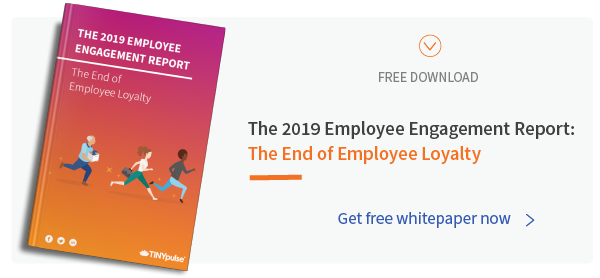How to Conduct Employee Surveys to Engage Your Team (And Grow Your Business)

Between monitoring finances and looking for new opportunities to scale your business, how do you manage to stay connected with your employees?
After all, receiving feedback from your team regarding employee engagement, the company culture, and management is the key to success.
But how do you juggle all of these chainsaws at once?
The answer is easier than you might think: through employee surveys.
Whether you’re a multimillion-dollar company or a venture that’s just starting out, you have to adopt a two-way approach when it comes to feedback. And the only way to do that is by actively asking your employees for feedback through surveys.
In this post, we’ll discuss what employee surveys are, why every company should conduct them, and how to do it the right way.
Let’s get started.
What Are Employee Surveys?
Employee surveys (sometimes referred to as employee feedback surveys) are tools that decision-makers use to gather valuable feedback from employees. This feedback can be about anything—ranging from the general satisfaction levels of employees to how their beliefs align with the company’s values.
With the help of employee surveys, you can find out about critical problems (which may otherwise be impossible to identify), uncover incredible ideas, engage employees, and retain top talent, among other things.
You can also measure the performance of your teams, acknowledge the efforts of individual employees, and learn more about their day-to-day challenges.
Why Conduct Employee Surveys?
You can accomplish a lot by conducting surveys.
For now, let’s jump straight into the tangible results that you can potentially experience by leveraging employee survey feedback.
1. Feedback Can Impact the Very Success of Your Business
Before getting into any specific areas, let’s get this out of the way first: Conducting employee surveys can actually impact the success of your business.
Surveying your employees and asking for their feedback raises their engagement levels.
This, in turn, can increase their overall performance.
You don’t have to take my word for it: Research indicates that about 71% of managers believe that employee engagement is critical to their organization’s success.
2. Employee Surveys Can Cut Down Turnover Rate
Employees who are listened to, appreciated, and consulted for both day-to-day and wide-scale decisions tend to stick around.
If you have a large team of say 100-plus employees, the only realistic way of accomplishing the above is by conducting surveys.
According to the TINYpulse Employee Recognition and Appreciation report, about 21.5% of employees who didn’t feel appreciated in their organizations had attended job interviews within the last three months.
Furthermore, a study by Salesforce revealed that an employee whose voice is heard is 4.6 times more times likely to try their hardest at work.
3. They Help You Take Action on Time
Another advantage of gathering feedback is that it allows you to act at just the right time.
For example, by leveraging the results from the employee survey, you can diffuse any ticking time bombs—such as counselling a manager who’s not clicking with the team.
Similarly, you can address other problems, make decisions before your competitors, and stay clear from any threats.
4 Universal Methods to Conducting Employee Surveys
Now that we’ve discussed the importance of collecting feedback, let’s take a look at how you can go about conducting these surveys.
In the simplest sense, an employee survey is a list of questions, or a single question, administered either with or without technology (e.g., email, online pages, and dedicated software). And depending on your company’s culture, you may or may not collect data anonymously.
The point is that there’s no rule of thumb that dictates how you should be conducting employee surveys.
However, depending on the scope (i.e. how specific you want to be in terms of areas and departments or depth of research) and frequency, there are four universal methods (or tactics, if you will) that you can try.
Here are the details:
1. Employee Spot
First on the list is the employee spot tactic. These surveys are meant to collect quick feedback on recent changes, developments, and events.
Employee spot surveys could include questions like this:
- What did you learn from the seminar?
- How were you affected by the recent change in the PTO policy?
Considering the above, employee spot surveys aren’t conducted as frequently as other kinds of surveys and have a limited scope.
2. Always-On Employee Engagement
As the name suggests, always-on employee engagement surveys are active throughout the year. As a result, they have a high frequency, and you collect data regularly.
However, in terms of scope (i.e., depth of research and analysis), they, too, are limited. These surveys may include questions such as:
- What is the one thing you would change about the company’s culture?
- How would you rate your overall experience?
In a way, they’re like suggestion boxes that employees can fill out anytime of the year (unless asked to do so at a specified rate).
3. Anchor
The anchor approach is the traditional method of conducting surveys. It involves gathering feedback once a year, which is why it’s placed lower in the frequency scale. However, these surveys have a broad scope.
Anchor surveys involve asking your employees 10, 20, or even a 100 questions—all at once— about engagement, culture, and performance, among other things.
For years, companies have been using this traditional approach. However, the biggest drawback of anchor surveys is the delay between the point at which problems arise and the point where employees can actually share them.
In fact, research conducted for our “The Science Behind TINYpulse Engage” piece showed that more than 30% of managers felt that data gathered through annual surveys wasn’t timely.
Ultimately, there’s no point in gathering feedback from an employee—who started feeling disengaged somewhere in the beginning of the year—almost 11 months later.
At that point, chances are that they’ve become actively disengaged or are even seeking employment elsewhere.
Besides, employees don’t fancy being bombarded with a long list of questions at once. When that happens, they often don’t answer the questions sincerely.
4. Pulse
Last, but not least, you can try the pulsing method—which is a relatively new and efficient way of gathering feedback throughout the year.
Pulse surveys involve asking employees asking one impactful and relevant question a week. Due to their brevity, these surveys score high in terms of both frequency and scope. Instead of gathering feedback once a year, you collect it in small increments—and just when it’s needed.
Despite seeming like a lot of work, the pulsing method is very effective. By using an employee survey app/platform like TINYpulse, you can easily collect fresh data every week and take action immediately.
Crucial Questions for Employee Surveys
While gathering feedback, it’s important to use the right employee survey questions. This is especially true if you’re going with the anchor/annual approach, which, according to our data, can cost almost $120,000 (for surveying 5,000 employees) nowadays.
Whether it’s a survey for employee satisfaction, engagement, or performance, you have to:
- Consider your goals or reasons behind conducting employee surveys (e.g., to address existing issues or identify potential threats and problems).
- Factor in the data collected from previous surveys.
- Consider where you currently stand in the industry.
While the questions that make up your survey completely depend on your requirements, here are some that you could potentially ask.
1. Are You Pleased with Our Company’s Culture?
It’s always a good idea to include a few employee survey questions about culture.
Being in the know of your corporate culture, and whether all employees are thriving in it, can be critical for your long-term success. Such information can help you reduce the employee turnover rate and cultivate the culture you want.
2. Are You Satisfied with Your Supervisor?
In addition to covering culture, you should also include employee survey questions about management every now and then.
This can help employees voice their opinions about their supervisors, who can make or break the team.
3. Do You Feel That Your Work Is Meaningful?
As a manager, you should always strive to make work meaningful for employees.
The first step is to use surveys to ask your employees whether they find their jobs purposeful or not. If you feel that an employee is losing interest, you can take the appropriate steps to ensure they stick around.
4. Do You Feel Recognized for Your Efforts and Achievements?
As discussed earlier, employees who aren’t appreciated for their hard work are more likely to quit.
To make sure that doesn’t happen to any of your employees, ask them if they’re being recognized and compensated for their efforts. Conduct employee surveys on benefits every once in a while to keep your team happy.
5. What Aspects Would You Change About Your Job?
Last but not least, include employee survey questions about the work environment, in general. Doing so can help you identify hidden issues that wouldn’t have considered otherwise.
The Benefits of Employee Surveys
With that out of the way, let’s discuss some specific benefits of employee surveys:
1. They Highlight Key Areas That Need Improvement
At the end of the day, the main reason why any company conducts surveys is to become better.
With employee satisfaction surveys, you can highlight the areas that need improvement—such as the management style, culture, and existing policies—before it’s too late.
2. Help Boost Employee Engagement
As discussed earlier, a tried-and-tested way to boost engagement is by asking your employees for their feedback and showing them that you care.
With the right approach, you’ll be heading a team of highly engaged employees who are loyal, dedicated, and sincere with their work.
3. Drive Decisions That Yield Results
Another important thing about conducting employee surveys is that it helps you make impactful decisions that are likely to yield positive results.
Without ample feedback, making critical management decisions is like throwing darts in the dark.
4. Compare Results with the Rest of the Industry
Lastly, by conducting employee feedback surveys, you’ll be able to create benchmarks and compare yourself with the rest of the industry. Using that information, you can take actions to stand out among competitors and attract top talent.
Common Mistakes to Avoid While Surveying Employees
To wrap up the article, let’s take a look at some common mistakes that companies make while surveying their employees:
1. Not Having Clear Goals
Don’t conduct surveys just for the sake of it.
It’s important to set clear goals before questioning your employees—even if you’re using the pulsing approach.
Potential goals could be:
- Measuring employee engagement
- Figuring out how to improve culture
- Finding out ways to stand out from competitors
Having clarity on what you hope to accomplish with the survey can help you ask the right questions.
2. Not Being Clear on Anonymity
Another common mistake that some companies make is not being clear about the anonymity of the responses.
When they’re not sure responses will be kept private, employees might feel reluctant to express their opinions—especially when they are about management.
In such cases, assuring your employees that their responses will be recorded anonymously can help you gather accurate information.
3. Asking the Same Questions Every Time
Avoid using the same questions in your employee surveys (with the exception of a few).
In addition to the questions being related to goals, they should be modified and updated according to the data collected through previous surveys.
4. Conducting a Survey Only Once a Year
Last but not least, companies should avoid conducting employee surveys only once a year.
As already discussed earlier, annual surveys are ineffective—and not to mention costly.
You always want fresh data that will allow you to solve the problems in advance—not months after they’ve occurred.
Ending Note
In an era where employees have the upper hand, conducting surveys isn’t an option. It’s a necessity.
By following the employee survey best practices and avoiding common mistakes, you can pinpoint the exact areas that need improvement, make timely decisions, and stay ahead of the competition.
That’s the ticket to happier employees, happier customers, and a healthier bottom line.
Share this
You May Also Like
These Related Stories
10 Questions You Need to Ask in Your First Employee Survey







.png?width=534&height=632&name=blog%20ad%20(1).png)
